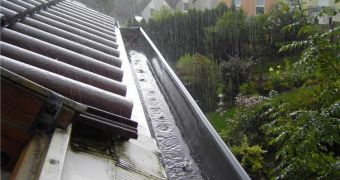Spanish researchers at the Autonomous University of Barcelona (UAB) say that building a particular type of roof can lead to the collection of more rainwater than currently possible with gravel-paved roof tops. Such a resource could have significant applications, the team adds.
Experts say that sloping roofs are capable of collecting about 50 percent more water than their flat counterparts. This water can then be used to wash streets, water gardens, fill cisterns, or even clean floors or vehicles.
The research group believes that rainwater-collecting system should be introduced in cities since the urban planning stage of construction projects. This would also boost the amount of water that can be collected, while providing various routes for the newly-formed streams to take.
The new study was conducted because experts got numerous questions as to which type of roof is best suited for collecting rainwater. So UAB investigators decided to carry out a proper scientific research on this issue, AlphaGalileo reports.
“It is important to consider the collection of rainwater when planning and designing cities, as this is an alternative water source with many different uses, it can even be used to save drinking water,” explains UAB expert Ramon Farreny.
He is the coauthor of a new project published in the scientific journal Water Research. The paper says that roofs “are the first choice for collecting rainwater in urban areas, but not all roofs function in the same way and it is necessary to select the most appropriate ones.”
The study was conducted for two years, between 2008 and 2010, using four different types of roofs (three of them slopped, coating metal and polycarbonate and one of them flat). The team found that metal- or plastic-covered, slopped roofs were the most efficient ones at collecting water.
At the same time, these roofs also provided a water of higher chemical and physical purity than the other two kinds. The chemical was not colonized by plants or microorganisms, and did not feature suspended particles as the others did.
“The inclusion of criteria related to the slope and roughness of roofs in urban planning may be useful in promoting the harvesting of rainwater as an alternative water source. This could also contribute to preventing flooding and water shortages,” Farreny concludes.

 14 DAY TRIAL //
14 DAY TRIAL //